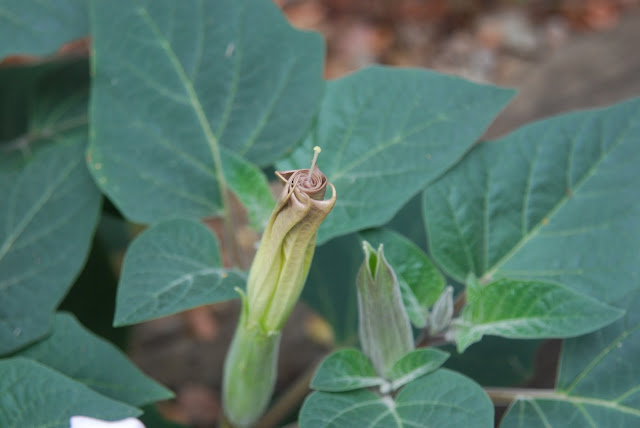In San Diego County we have had our usual Fifty Shades of May Grey which is the result of rising warm air inland that draws cooler, moisture filled air off the ocean. This is actually good for plants on the coast because it delivers some dew at night and keeps the soil from heating up and drying out too soon. It is often followed by June Gloom... more of the same.
But in my garden, what we have right now is June Bloom. It seems like there is more stuff in flower than I typically have in June, possibly as a result of the late rains we had. Let's start with Madia elegans. I bought it from Annie's Annuals specifically because it is a Summer bloomer, as I discussed in last month's post. There is at least one recognized subspecies, maybe more depending on who you ask, and I don't know which subspecies this is. Mine seems to lack red coloring in the center of the ray flowers. It has a light scent, vaguely like pineapple. The stem is covered with glandular, sticky hairs. I bought four, and mine have grown quite vigorously since I planted them just about a month ago. They look like they will go strong all Summer long.
Another one that I planted this Spring (don't recall exactly when) is Datura wrightii (Western Jimson Weed). The first thing that must be said about this plant is that it is POISONOUS, especially the seeds, so if one is going to grow this one must be cautious handling the seeds or pods and storing them around kids or pets. It is in the Solanaceae or Nightshade family, the same as peppers, tomatoes and potatoes but also the same as Belladonna, so you have been warned. Aside from that, it is a beautiful plant, easy to grow, with a lovely lemony scent. The flowers generally open in the evening, unfurling like an umbrella into a large trumpet shape, typically white with some purple on the edges or throat of the flower. Like other scented, white, night-blooming flowers, it is pollinated by moths and other nocturnal insects. Each flower lasts less than 24 hours. If the plant is happy it will produce lots of flowers over the course of the Summer. It's an herbaceous perennial so it will die back to the ground after its season is done but then should return again the next season. In the first photo below you can see the extra long pistil emerging first from the flower bud before it unfurls
One cactus that doesn't bloom for me every year is Myrtillocactus cochal, a Baja endemic and one of my favorites in the wild. In my garden it hasn't done much, perhaps because I've had to move it a couple of times, and it is naturally slow-growing. This year it has had several blooms, which hasn't happened in a long time. The flowers are small, white, with a mass of stamen sticking out to attach their pollen to anything that comes close. They open in the daytime and last a few days, so I'm guessing bees are their primary pollinators. The fruit is said to be edible but I haven't tried it. In the photo below are an open flower and a fruit. In my garden I have it growing with Agave shawii, Bergerocactus emoryi, and Dudleya brittonii, all of which you would see together if you were driving on Highway 1 south of Ensenada. I love Baja!
One of my favorite flowers, but one that is not easy for me to grow, is Delphinium cardinale, Scarlet Larkspur. The flowers are a gorgeous crimson, held in a cluster on a tall stalk. The "Larkspur" name refers to the funnel shape that is formed by the petals being fused into a pointed tube. This funnel does not attach to the pedicel (flower stalk that attached to the main stem) but hangs out separately like a spur. The first time I grew this plant, several years ago, I had the best success and I don't know why. Since then I have struggled to get the plants to maturity so they will bloom. Also, it is a perennial herb that should come back from its roots each year, but mine have never done that. I have to buy new plants every year. This year I bought six plants. Only two have survived and only one of those has bloomed. Oh well, at least the one that bloomed looks great. I'll see if I can get that one to come back next year. It is supposed to remain dry during its Summer dormancy. I can arrange that.
The other end of the spectrum is Oenothera elata, Hooker's Evening Primrose. It is also a perennial herb, but in addition it produces abundant seeds. It isn't the most beautiful plant in the garden as it tends to get leggy and rangy and kind of weedy looking. It produces so many seedlings that I have to weed them out or I'll be overtaken by them. Yet I have to admire its reliability. It comes back every year, rain or drought, sun or shade, and it produces abundant yellow flowers that are much used by bees, flower flies, wasps, butterflies, etc. The annoying seedlings are at least easy to identify and pull. I really can't complain too much, and it will always have a place in my garden.
I will close with this shot of a bee in a Malacothamnus fasciculatus flower. Although bees are having a hard time in general, I'm happy to see that they are going strong in my garden.






